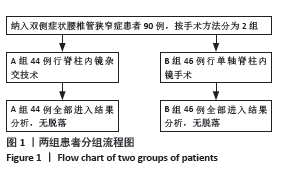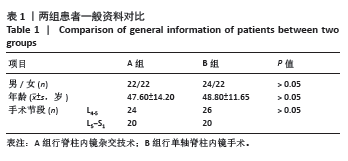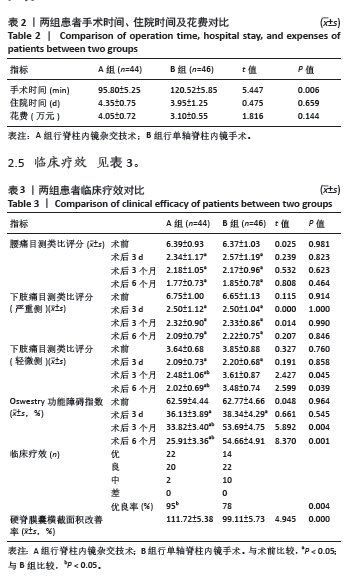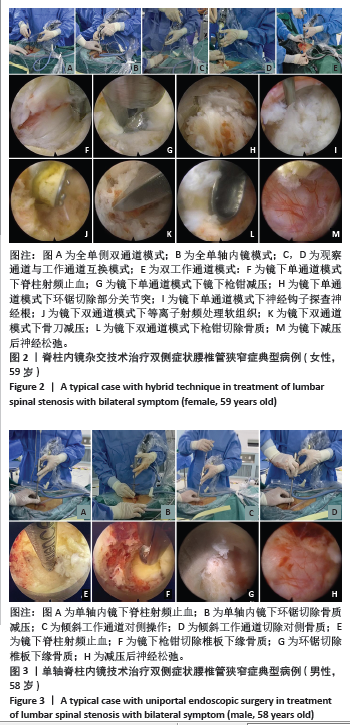[1] KATZ JN, ZIMMERMAN ZE, MASS H, et al. Diagnosis and management of lumbar spinal stenosis: a review. JAMA. 2022;327(17):1688-1699.
[2] KARLSSON T, FÖRSTH P, SKORPIL M, et al. Decompression alone or decompression with fusion for lumbar spinal stenosis: a randomized clinical trial with two-year MRI follow-up. Bone Joint J. 2022;104-B(12): 1343-1351.
[3] GADJRADJ PS, BASILIOUS M, GOLDBERG JL, et al. Decompression alone versus decompression with fusion in patients with lumbar spinal stenosis with degenerative spondylolisthesis: a systematic review and meta-analysis. Eur Spine J. 2023;32(3):1054-1067.
[4] LI Z, WANG X, XIE T, et al. Oblique lumbar interbody fusion combined with stress end plate augmentation and anterolateral screw fixation for degenerative lumbar spinal stenosis with osteoporosis: a matched-pair case-controlled study. Spine J. 2023;23(4):523-532.
[5] SILVA PS, JARDIM A, PEREIRA J, et al. Minimally invasive fusion surgery for patients with degenerative spondylolisthesis and severe lumbar spinal stenosis: a comparative study between MIDLIF and TLIF. Eur Spine J. 2023;32(9):3210-3217.
[6] DIMITRIOU D, WINKLER E, WEBER S, et al. A simple preoperative score predicting failure following decompression surgery for degenerative lumbar spinal stenosis. Spine (Phila Pa 1976). 2023;48(9):610-616.
[7] GAGLIARDI MJ, GUIROY AJ, CAMINO-WILLHUBER G, et al. Is indirect decompression and fusion more effective than direct decompression and fusion for treating degenerative lumbar spinal stenosis with instability? a systematic review and meta-analysis. Global Spine J. 2023; 13(2):499-511.
[8] ALHAUG OK, DOLATOWSKI FC, SOLBERG TK, et al. Predictors for failure after surgery for lumbar spinal stenosis: a prospective observational study. Spine J. 2023;23(2):261-270.
[9] DANTAS FL, DANTAS F, CAIRES AC, et al. Adjacent segment degeneration after posterolateral lumbar fusion: results and complications of posterior revision surgery. J Neurosurg Sci. 2023;67(4):446-453.
[10] CHEN Z, ZHANG L, DONG J, et al. Percutaneous transforaminal endoscopic discectomy versus microendoscopic discectomy for lumbar disc herniation: two-year results of a randomized controlled trial. Spine. 2020;45(8):493-503.
[11] LOKHANDE PV. Full endoscopic spine surgery. J Orthop. 2023;40:74-82.
[12] CHEN KT, KIM JS, HUANG AP, et al. Current indications for spinal endoscopic surgery and potential for future expansion. Neurospine. 2023;20(1):33-42.
[13] KANG MS, YOU KH, HAN SY, et al. Percutaneous full-endoscopic versus biportal endoscopic posterior cervical foraminotomy for unilateral cervical foraminal disc disease. Clin Orthop Surg. 2022;14(4):539-547.
[14] JU CI, LEE SM. Complications and management of endoscopic spinal surgery. Neurospine. 2023;20(1):56-77.
[15] BALAIN B, BHACHU DS, GADKARI A, et al. 2nd and 3rd generation full endoscopic lumbar spine surgery: clinical safety and learning curve. Eur Spine J. 2023;32(8):2796-2804.
[16] WU PH, CHIN BZJ, LEE P, et al. Ambulatory uniportal versus biportal endoscopic unilateral laminotomy with bilateral decompression for lumbar spinal stenosis-cohort study using a prospective registry. Eur Spine J. 2023;32(8):2726-2735.
[17] WANG L, LI C, HAN K, et al. Comparison of clinical outcomes and muscle invasiveness between unilateral biportal endoscopic discectomy and percutaneous endoscopic interlaminar discectomy for lumbar disc herniation at L5/S1 Level. Orthop Surg. 2023;15(3):695-703.
[18] LI YS, CHEN CM, HSU CJ, et al. Complications of unilateral biportal endoscopic lumbar discectomy: a systematic review. World Neurosurg. 2022;168:359-368.
[19] CHEN Z, ZHOU H, WANG X, et al. Complications of unilateral biportal endoscopic spinal surgery for lumbar spinal stenosis: a meta-analysis and systematic review. World Neurosurg. 2023;170:e371-e379.
[20] ZHU C, CHENG W, WANG D, et al. A helpful third portal for unilateral biportal end08copic decompression in patients with cervical spondylotic myelopathy: a technical note. World Neurosurg. 2022;161;75-81.
[21] 晏美俊,郭松,付强,等. 三种内镜手术技术治疗神经根型颈椎病的临床疗效比较[J]. 中国脊柱脊髓杂志,2023,33(7):610-618.
[22] MARTIN BI, MIRZA SK, SPINA N, et al. Trends in lumbar fusion procedure rates and associated hospital costs for degenerative spinal diseases in the united states, 2004 to 2015. Spine (Phila Pa 1976). 2019;44(5):369-376.
[23] DERMAN PB, OHNMEISS DD, LAUDERBACK A, et al. Indirect decompression for the treatment of degenerative lumbar stenosis. Int J Spine Surg. 2021;15(6):1066-1071.
[24] YASAR B, SIMSEK S, ER U, et al. Functional and clinicalevaluation for the surgical treatment of degenerative stenosis of the lumbar spinal canal. J Neurosurg Spine. 2009;11(3):347-352.
[25] IMAJO Y, TAGUCHI T, NEO M, et al. Complications of spinal surgery for elderly patients with lumbar spinal stenosis in a super-aging country: An analysis of 8033 patients. Orthop Sci. 2017;22(1):10-15.
[26] SATO J, OHTORL S, ORITA S, et al. Radiographic evaluation of indirect decompression of mini-open anterior retroperitoneal lumbar interbody fusion: oblique lateral interbody fusion for degenerated lumbar spondylolisthesis. Eur Spine. 2017;26(3):671-678.
[27] HAYAMA S, NAKANO A, NAKAYA Y, et al. The evaluation of indirect neural decompression after lateral lumbar interbody fusion using intraoperative computed tomography myelogram. World Neurosurg. 2018;120:e710-e718.
[28] KIM MC, PARK JU, KIM WC, et al. Unilateral-approach minimally invasive transforaminal lumbar interbody fusion attain indirect contralateral decompression? A preliminary report of 66 MRI analysis. Eur Spine. 2014;23:1144-1149.
[29] 汪翔,卜星平,吴小涛.微创单侧入路双侧减压固定与开放双侧减压固定治疗单间隙腰椎管狭窄症的疗效比较[J]. 临床外科杂志, 2018,26(12):951-954.
[30] 迟成,张建党,邹德威. 单侧症状的双侧腰椎神经根管狭窄行单、双侧减压的前瞻性研究[J]. 中国脊柱脊髓杂志,2013,23(4):325-329.
[31] KOMP M, HAHN P, MERK H, et al. Bilateral operation of lumbar degenerative central spinal stenosis in full-endoscopic interlaminar technique with unilateral approach: prospective 2-year results of 74 patients. J Spinal Disord Tech. 2011;24(5):281-287.
[32] CHEN MJ, YANG C, ZHANG SY, et al. Use of Coblation in arthroscopic surgery of the temporomandibular joint. J Oral Maxillofac Surg. 2010; 68(9):2085-2091.
[33] 徐浩严. 单侧双通道脊柱内镜与单通道脊柱内镜行ULBD治疗腰椎管狭窄症的疗效对比[D]. 大连: 大连医科大学,2021.
[34] CHOI KC, SHIM HK, HWANG JS, et al. Comparison of surgical invasiveness between microdiscectomy and 3 different endoscopic discectomy techniques for lumbar disc herniation. World Neurosurg. 2018;116:e750-e758. |




